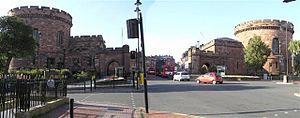Cumberland County Council, England facts for kids
Quick facts for kids Cumberland County Council |
|
|---|---|

Coat of arms
|
|
| History | |
| Founded | 1 April 1889 |
| Disbanded | 31 March 1974 |
| Succeeded by | Cumbria County Council |
| Meeting place | |
 |
|
| The Courts, Carlisle | |
Cumberland County Council was a local government group in the North West of England. It was in charge of many important services in the area called Cumberland. This council started in 1889 because of a new law. It helped manage things like roads, schools, and social care for people.
At first, the city of Carlisle was part of its area. But in 1914, Carlisle became a separate "county borough" and managed its own services. In 1974, Cumberland County Council and Carlisle's council joined with other areas to form a new, bigger council called Cumbria County Council. In April 2023, local government in Cumbria changed again. A new council called Cumberland Council was formed. It covers most of the old Cumberland area, except for Penrith and its surroundings.
Contents
History of County Councils
County councils were first set up in England and Wales. They started with full powers on September 22, 1889. This happened because of a law called the Local Government Act 1888.
Before this, local services were run by unelected groups. The new councils took over these jobs. The areas they looked after were called "administrative counties." In Cumberland, the whole county was initially under the council's authority.
First Elections and New Responsibilities
The very first elections for the new county council happened in January 1889. People voted for their local representatives. This new system was a big step for local democracy. It showed how local government was growing and taking on more tasks.
For example, in 1902, schools became a new responsibility. The County Council then looked after both primary and secondary schools.
Services Provided by the Council
Throughout its time, Cumberland County Council managed important local services. By the time it joined with Cumbria, it offered many different services. These included:
- Education: running schools, libraries, and youth services.
- Social services: helping people in need.
- Highway maintenance: keeping roads in good condition.
- Waste disposal: managing rubbish.
- Emergency planning: preparing for emergencies.
- Consumer protection: making sure businesses were fair.
- Town and country planning: planning for new buildings and land use.
Because of all these jobs, the council was a major employer in the area.
Changes in Local Districts
Over time, smaller local groups worked alongside the county council. These groups handled more local services. A law in 1894 created urban and rural districts, each with its own elected council.
Later, in 1929, another law made county councils review these districts. The goal was to make local government more efficient. In Cumberland, districts were merged in 1934 to create better working units.
Carlisle's Special Status
The Local Government Act of 1888 allowed large towns to become "county boroughs." If a town had more than 50,000 people, it could manage all its own local services. This meant it would not be under the county council.
In 1914, Carlisle became a county borough. It then managed its own services. However, Carlisle still remained part of the larger geographic county of Cumberland for some official purposes.
End of the Council in 1974
In 1974, a new law, the Local Government Act 1972, changed things again. Both the administrative county of Cumberland and the county borough of Carlisle were ended. Their areas were combined with other parts of England.
These areas included Westmorland, parts of Lancashire, and parts of West Riding of Yorkshire. Together, they formed a new county called Cumbria. The old Cumberland area was then divided into smaller districts. These new districts were the City of Carlisle, Allerdale, Copeland, and part of Eden.
One of the council's last big projects was a new A66 bypass for Keswick. Work on this road started in the summer of 1974. The new Cumbria authority then finished the project.
Council Elections
From 1889 to 1969, council members were elected for a three-year term. Later, this changed to a four-year term. Elections were held using the "first past the post" system. This means the candidate with the most votes wins.
Each area of the county elected one member. These elected members then chose additional voting members called aldermen. Aldermen served for six years.
1889 Election Results
The first election for the council was held on Friday, January 18, 1889. There were 60 councillors to be elected. In some areas, candidates were elected without anyone running against them.
After the election, 79 out of 80 seats were filled. The results showed:
- 37 Liberals
- 33 Conservatives
- 9 Liberal Unionists
The Liberals won all the seats in West Cumberland. This was seen as a big win for their party.
1892 Election Results
The second election took place on Friday, March 4, 1892. Only 22 out of 60 seats were contested, meaning 38 members were elected without opposition. There were only small changes, with just 4 sitting members losing their seats.
The political makeup of the 60 elected councillors was:
- 29 Conservatives
- 27 Liberals
- 4 Liberal Unionists
1970 Election Results
The very last election for the Cumberland County Council was held on Thursday, April 9, 1970. After this election, the council was made up of:
- 27 Independents (not linked to a specific party)
- 21 Labour members
- 11 Conservatives
- 2 Liberals
Labour gained 2 seats in this election, mostly from the Independents.
Notable Members
- Sir Frederick William Chance
- Rev. Hardwicke Rawnsley (elected 1889)
- Ambrose Callighan (elected 1921)
- Sir John Scurrah Randles
- Tim Westoll, chairman from 1959 to 1974, and also the first chairman of Cumbria County Council

